#i just think we should question any man who befriends a filmmaker in the last year of his life
Explore tagged Tumblr posts
Note
I apologize if you have talked about this before but: what are your thoughts on Ray Carney, especially his beef with Gena Rowlands? I enjoyed his written works on Cass, but am having a hard time understanding what went down there irl
i hate him with a burning passion, think he’s completely in the wrong, and he’s fucking delusional if he thinks he is somehow a better judge of john and his wishes than the woman who was his life partner for twenty five years. he met him in the last year of his life! but gena is the villain for not wanting films john didn’t want shown to the public shown to the public lol. he can bite me. also his website sucks and i don’t hate his books about john but there’s a smugness there that i find hard to swallow
#asks#i just think we should question any man who befriends a filmmaker in the last year of his life#and then immediately picks fights with his widow and accuses her of trying to control his legacy or whatever#as his wife and muse and the woman he loved the most i think that’s her right
7 notes
·
View notes
Text
When Can Artists Bend Ethics for Art’s Sake?
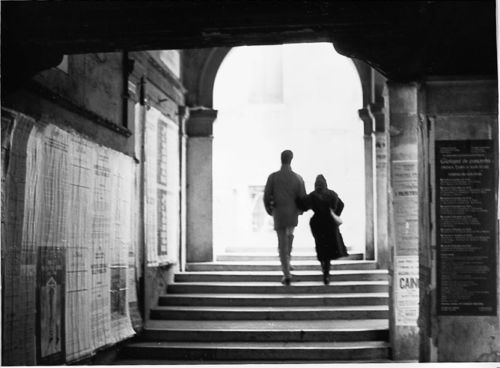
Sophie Calle, Suite Vénitienne, 1980. “At the end of January 1980, on the streets of Paris, I followed a man whom I lost sight of a few minutes later in the crowd. That very evening, quite by chance, he was introduced to me at an opening. During the course of our conversation, he told me he was planning an imminent trip to Venice. So I decided to follow him.” © Sophie Calle / ADAGP, Paris & ARS, New York, 2018. Courtesy of Perrotin.
What right does an artist have to use other people in their work—to invade their lives, violate their privacy, or cause them harm? What will we forgive in the name of art?
These are the questions I was asking a decade ago when, for a graduate performance art class taught by Tania Bruguera, I paid a classmate $1 to befriend my best friend Laura and write reports on how she thought Laura was coping after a recent break-up. At our final class, I passed around a folder containing these reports and a photocopy of the $1 check I’d written. The folder reached Laura last. I watched across the table as she read the document of my simultaneous care and betrayal.
I got an A for the class, but lost my friend. It was a horrible thing to do, but I was 21 and obsessed with Sophie Calle and the line between art and life. Since the 1970s, Calle has repeatedly invited us to question whether artists should be held to the same standards as other people. In viewing her work, we must ask whether invading someone’s privacy or betraying their trust is an acceptable emotional cost to art.
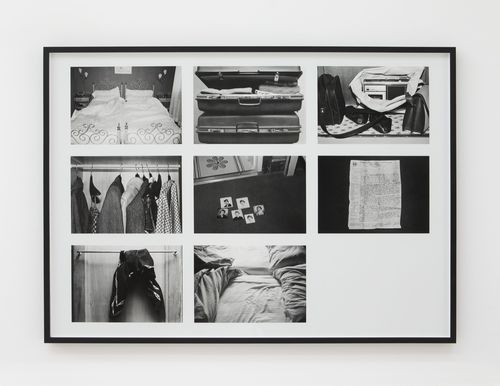
Sophie Calle, The Hotel, 1981. “On Monday February 16, 1981, I was hired as a temporary chambermaid for three weeks in a Venetian hotel. I was assigned twelve bedrooms on the fourth floor. In the course of my cleaning duties, I examined the personal belongings of the hotel guests and observed through details lives which remained unknown to me. On Friday March 6, the job came to an end.” © Sophie Calle / ADAGP, Paris & ARS, New York, 2018. Courtesy of Perrotin.
In 1979, Calle followed a man she’d met at an art opening in Paris to Venice, where she spent two weeks spying on and photographing him as he went about his business in the city. She presented the images alongside text detailing both her observations and emotions during the period, as Suite Vénitienne. This man, identified only as Henri B., was the first unwitting participant to Calle’s artistic game.
In 1983, she found a lost address book on the street and photocopied the contents before returning it. She then telephoned each of the contacts to question them on the identity of the owner, and published her findings as a series (“The Address Book”) in the French newspaper Libération. The owner, the documentary filmmaker Pierre Baudry, threatened to sue her, wrote open letters to Libération, and eventually sent the paper a nude photo of Calle that he demanded they publish as retaliation. This literal tit-for-tat response to her exposure of his identity did not perturb Calle; she ultimately incorporated it into the piece.
For The Hotel (1983), Calle worked as a chambermaid, exploring and documenting the private belongings and writings of hotel guests. Observing this piece, we experience both Calle’s curiosity and the unsettling thought that, at every hotel we have ever stayed in, our own possessions might have been subjected to similar scrutiny. What might someone like Calle have learned from our nightgowns and slippers, our diaries and postcards? How might she have misinterpreted us?
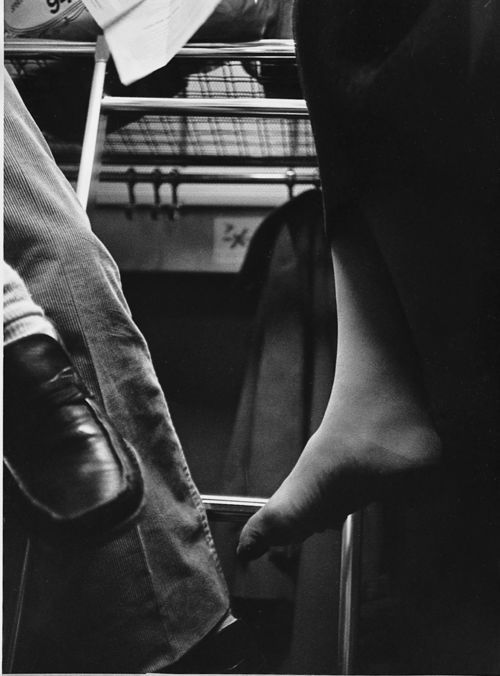
Sophie Calle, Suite Vénitienne, 1980. © Sophie Calle / ADAGP, Paris & ARS, New York, 2018. Courtesy of Perrotin.
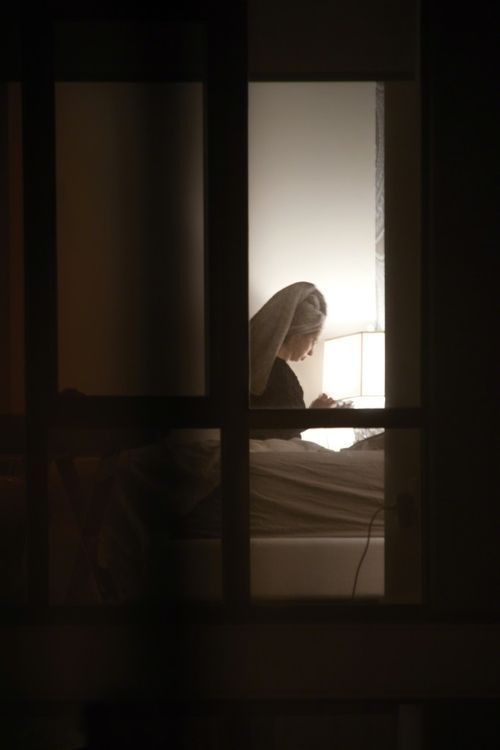
Neighbors #14, 2012. Arne Svenson Robert Klein Gallery
A crucial element of these early pieces is Calle’s involvement of the viewer in her transgressions. By inviting us to immerse ourselves in the narratives of her observations, she makes us complicit in her voyeurism—even as we question it. It is not just Calle invading these strangers’ privacy and observing their lives without consent, but us, too. We may not agree with her methods, but by engaging with the work, we find ourselves tacitly condoning it.
Decades later, though, the question that still hangs over these pieces is whether or not they were ethical. Did Henri B., Pierre Baudry, or those hotel guests have a right to privacy? Can any of us expect to be protected from the artist’s gaze?
In 2013, Arne Svenson caused a Calle-like controversy for using a telephoto lens to take photos of his Manhattan neighbors, later exhibiting the work in a local gallery. Svenson was sued, but won the case based on his First Amendment rights, and “The Neighbors” went on to be exhibited across the country. Though the discussion continues as to whether Svenson’s photographs of families, children, pets, and intimate, private spaces is ethically acceptable, the judge’s ruling makes clear that legally, at least artists have a right to invade aspects of our privacy.
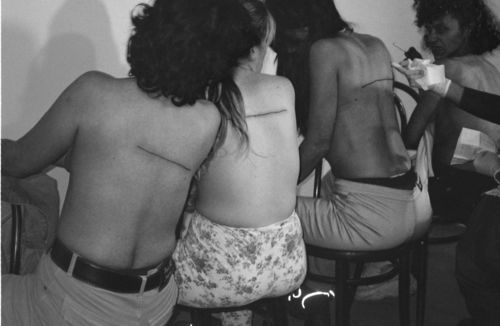
Santiago Sierra, 160 CM LINE TATTOOED ON 4 PEOPLE, El Gallo Arte Contemporaneo. Salamanca, Spain. December 2000, 2000. © Santiago Sierra. Courtesy of Lisson Gallery.
Considered in conjunction with conversations about digital surveillance, data protection, and online privacy—not to mention random strangers who might be livetweeting intimate exchanges—this ruling might seem rather scary. Belgian artist Dries Depoorter uses digital technology to explore this fear. For Tinder In (2015), Depoorter traced women (and some men) who appeared on his Tinder app to their LinkedIn profiles, then displayed and published their profile pictures from each side by side, pointing out both the ease with which individuals can be traced, and the split-personalities of online identities.
The interesting thing about all of these pieces is that, while their controversy lies in the question of an individual’s right to privacy, the works themselves actually reveal very little about their subjects. In reading the texts accompanying Calle’s work, we learn much more about the stalker than the stalked. It’s easy to understand the sense of invasion felt by Henri B. and Pierre Baudry, as well as Svenson’s neighbors and Depoorter’s Tinder matches, but perhaps the true grievance is that the artists have used these strangers’ images and identities to create works that have nothing to do with them.
Spanish artist Santiago Sierra’s use of anonymous individuals raises similar ethical questions, though rather than invading their privacy, he asks them to submit to him bodily. For 160cm Line Tattooed on 4 People (2000), he paid heroin-addicted prostitutes the price of a shot of the drug to allow him to tattoo them. For Group of Persons Facing a Wall (2002), he paid homeless women the price of a night in a hostel to stand facing a gallery wall. And for 10 People Paid to Masturbate (2000), he paid workers $20 to masturbate in front of a camera.
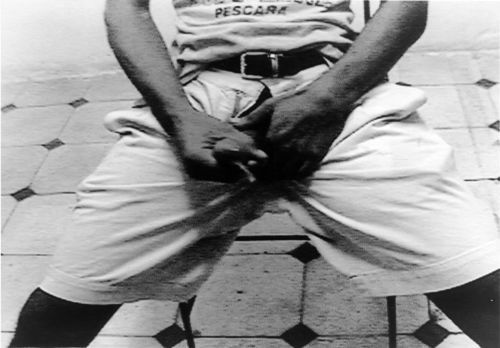
Santiago Sierra, 10 PEOPLE PAID TO MASTURBATE, Tejadillo Street, Havana, Cuba. November 2000, 2000. © Santiago Sierra. Courtesy of Lisson Gallery.
Unlike Calle, Svenson, and Depoorter, Sierra does seek consent from his subjects, but the nature of this consent is highly questionable. These pieces draw attention to the exploitative, transactional nature of our society, pointing to the commodification of bodies and exposing the power structures that operate within our everyday lives. Conceptually and politically, the works might be seen as noble, but in actually using the bodies of vulnerable individuals, Sierra must enact the very exploitation and dehumanization he critiques. He forces us to ask if it is okay for an artist to use people. Can the end justify the means?
In 1992, Paul Auster based a character in his novel Leviathan on Sophie Calle, borrowing some of her works as well as inventing new ones. This depiction of Calle is heavily critiqued in Chris Kraus’s autofictional novel I Love Dick (1997); she claims Auster’s version of Calle is “a waif-like creature relieved of complications like ambition and career.” Ironically, this criticism—that using a real person as the subject for art strips that person of their individuality and complexities—can be levelled just as fairly at Suite Vénitienne, The Address Book, and The Hotel. Like Auster, Calle presents her subjects as simplified versions of themselves, and treats them like fictional characters in a narrative she remains in control of.
It is, I think, this relieving of complications that is most disturbing and, in the end, most painful. Should we find ourselves the subject of an artist’s gaze, most of us would like them to see the whole of us, to render us fairly and try to understand our complexities. Unfortunately, the artist’s motive is often more to do with projecting or reflecting a part of themselves rather than reaching an empathetic understanding of their subjects. What they were looking for, really, is a mirror.
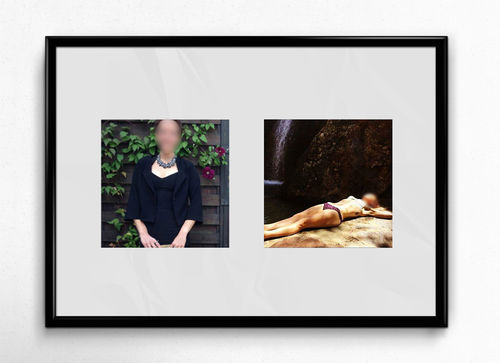
Dries Depoorter, Tinder In, 2015. Courtesy of the artist.
In the play between the private and the public, artists have both the ability and the right to provoke, shock, and disturb. What we often fail to recognize, however, is that by giving them a platform, it is us as viewers who have bestowed this position of power upon them. By consuming and applauding Calle’s early works, we effectively opened our own curtains to Svenson and gave our profile photos to Depoorter. Perhaps the question is not whether artists have the right to invade our privacy or cause us harm, but why we’ve allowed them to.
I’m not proud of what I did to Laura back in grad school. A decade later, I’m appalled by my callousness and can hardly remember my own justifications. But I do remember the surprise I felt at her anger. I remember expecting her to understand, wanting her to acknowledge my cleverness, to think about the nuances of privacy and trust, and sense as I did the precarious power wielded by the word “art.” I wonder if it is this kind of optimistic thinking that drives Calle and other artists. For those who have devoted their lives to their work, perhaps it doesn’t seem so extraordinary for them to imagine others should be willing to devote theirs, too.
from Artsy News
1 note
·
View note
Text
WHAT TO WATCH THIS WEEKEND September 13, 2019 - ONE CUT OF THE DEAD, FREAKS, HUSTLERS, THE GOLDFINCH and more
We’re well into September, and the Toronto Film Festival is slowly grinding to a halt as I continue to sulk for missing so many movies that I won’t be able to see until November or December. At least I’ll be at the New York Film Festival this month, and there’s a little bit of overlap there.
Besides the wide releases, there’s some really good limited releases this week, but I want to focus specifically on three movies that played at the What the Fest?! in New York City back in March:

The first of them is the Japanese zombie horror-comedy ONE CUT OF THE DEAD from director Shin'ichirô Ueda, which Shudder is releasing and streaming after it played a number of festivals including last year’s Fantastic Fest. What can I say about this really innovative film? I guess I can tell you that it’s about a zombie attack on the crew of a zombie movie, but that wouldn’t be the whole story. Honestly, it’s best to go in not knowing too much about it, other than it’s not your typical zombie movie. The complex intricacies of what Ueda does with his cast makes this one of my favorite recent zombie-related movies since the similarly great Korean film, Train to Busan. One Cut of the Dead will be released in New York (at the IFC Center) and in L.A. on Friday but then it will get special one-night screenings next Tuesday (Sept 17) in other citiesbefore premiering on the Shudder streaming channel sometime down the road. And if you’ve been wondering why everyone who sees this movie keeps yelling “Pom!,” well you’ll just have to see the movie for yourself.
Another great movie from “What The Fest!?” is Zach Lipovsky and Adam Stein’s FREAKS (Well Go USA), which will open a little wider than some of the other limited releases this weekend. It stars relative newcomer Lexy Kolker as Chloe, a young girl living in a world where those with powers are considered “freaks,” shunned and captured for experiments. Her father (Emile Hirsch) has been keeping her in hiding, but as Chloe gets older, she has questions about her mother, and also, there’s that weird ice cream man (Bruce Dern) who seems to know about her. Freaksis really a fantastic film from these filmmakers, Lipovsky having directed Leprechaun: Originsa few years back. I was truly impressed with Kolker’s performance opposite much more experienced actors, and Lipovsky/Stein find a way to build up the story to a satisfying climax.
I’ll have an interview with the directors over at The Beat later this week, as well.
I also want to call attention to DEPRAVED (IFC Midnight), the new film from director Larry Fessenden, which is his take on the Frankenstein mythos with David Call playing Henry, an army medic who decides to build a human being called Adam (played by Alex Breux), but finds his invention hard to control as Adam remembers his past. Another “What the Fest?” vet (actually, this year’s opening night film), Depraved also stars Joshua Leonard, Chloë Levine and Ana Kayne, and it’s so nice to have Larry back making movies. You can read more with Larry in my interview over at The Beat.
And then of course, there are this week’s wide releases, STXfilms’ HUSTLERS and Warner Bros’ THE GOLDFINCH, which I’m hoping I get to see one or both by the time this posts. If so, I’ll have review of both of these movies below. (Note: I did get to them, and they’re both interesting movies in that neither of them was anything like I expected.)
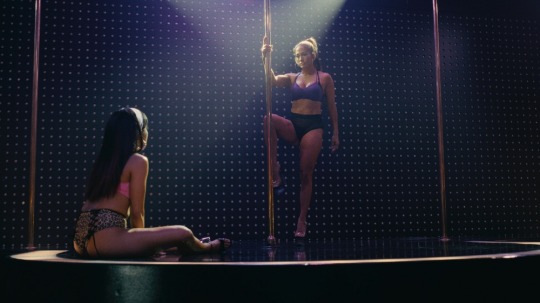
I’m really curious about HUSTLERS (STXFilms), because it’s the third film from director Lorene Scafaria, whose previous films, Seeking a Friend for the End of the World and The Meddler, I quite enjoyed, mainly because they featured actresses I like. I can take or leave Jennifer Lopez, but I genuinely love Constance Wu, and I really want to see what she can do in a more dramatic role. And then, of course, there’s the premise of New York strippers scamming a bunch of sleezy rich men out of their money, which is based on a New York Magazine article. That’s just one of those great pitches that makes me think many will be interested in checking it out this weekend, and it might do better than expected.
Mini-Review: I honestly think Hustlers is going to be an interesting litmus test for whether people who usually frown or turn their noses at the very real adult entertainment business that permeates big cities and small towns alike will be able to look past the setting to appreciate it for the skillful crime-drama that it is.
The film begins in 2007 with Constance Wu’s Dorothy on her first day at a big New York City strip club where she has to deal with slimy Wall Street types and equally sleazy bosses who take a big chunk of her earnings. Things change when she meets Jennifer Lopez’s Ramona, the absolute queen of the strip club scene, which you can tell as you first watch her performing. Ramona knows the ropes and takes a liking to “Destiny” (Dorothy’s stripper name) enough to befriend her and give her some tips.
After a bit more shenanigans explaining how things work in stripping, the story then cuts forward years later after Dorothy has had a child and is a single mother needing money. She returns to the club but business isn’t as good after 2008 as the Wall Street jerks aren’t as anxious to throw their money around. When Ramona reenters her life, the two of them come up with a scheme to drug their marks and then empty out their credit cards of money. It’s going well, and they’re getting away with it to the point where they need to expand.
Although Scafaria uses a fairly standard format to tell this story in the screenplay – basically having Constance Wu telling Julia Styles’ reporter the story as it plays out -- it’s the way she allows the story to unfold which allows the film to improve as it goes along. Sure, it’s a little predictable where and how things are going to go wrong, but the movie still works on quite a few levels beginning with the performances by Wu and J-Lo that a lot of people will be talking about later. When we first see Lopez dancing, she looks absolutely amazing, and it must be incredibly empowering for a former dancer now 50 years old to be able to get on stage with barely any clothes on and strut her stuff.
A lot of why the movie doesn’t come across as sleazy as it might otherwise (such as in the hands of a male director) is the way that Scafaria focuses so much on the friendship between Ramona and Dorothy and what happens as things start breaking down between them, especially when Dorothy starts growing a conscience. The rest of the mostly-female cast is great, although most of the men in the movie are depicted as such slimy and disgusting pigs, it’s hard to feel sorry for them either.
Hustlers is the type of movie that we wouldn’t blink if Scorsese or even producer Adam McKay had directed, but the fact that Scafaria can transition so smoothly from her light comedies to something so well-constructed is part of why the movie is so impressive.
I’m not sure if women who see this movie will rush out to take stripping classes in order to fuel their sense of empowerment, but Hustlers is a genuinely enjoyable film that tells a fascinating story and Scafaria should get full credit for making another movie this good.
Rating: 8/10
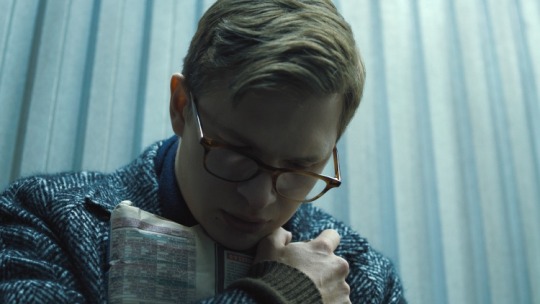
I don’t know nearly as much about THE GOLDFINCH (Warner Bros.) except that it’s based on a best-selling Pulitzer price-winning book by author Donna Tartt, and it has an insane cast that includes Ansel Elgort, Nicole Kidman and Jeffrey Wright. I know that reviews out of TIFF were not good, and I’m not sure it will find an audience even with the popularity of the book.
Mini-Review: I haven’t read The Goldfinch, and actually, I’m kind of glad I didn’t read it before seeing this John Crowley-directed movie, because it might have taken away from one of the main reasons I enjoyed it.
The basic premise is simple but the overall story and movie that tells the story is quite complex, maybe needlessly so, but if I didn’t know this movie was based on a beloved book, I could totally have guessed that was the case since so much of what happens in the movie is more literary than cinematic… though not necessarily in a bad way.
The story revolves around Theo Decker, played as a youngster by Oakes Fegley and about ten years older by Ansel Elgort. We meet Theo shortly after his mother was killed in an explosion at the Metropolitan Museum of Art, after which he’s turned over to the wealthy Barbour family, his friend Andy’s mother overjoyed to bring Theo into their family of five. Just when things are going well, Theo’s real father (Luke Wilson) shows up and drags the boy back to his home in a desolate area outside Vegas with his white trash girlfriend (played by an unrecognizable Sarah Paulson). There, Theo makes a new friend in Boris (Finn Wolfhard), and the two of them get into trouble, smoking cigarettes, drinking and doing drugs. And then stuff happens.
If you haven’t read the book, I’m not going to do a play-by-play on the plot, because SO MUCH happens in this movie, and that’s part of why it’s enjoyable because it’s such rich and dense storytelling ably pulled together by Brooklyn director John Crowley.
One of the things I will mention is the movie’s title “The Goldfinch” which is a priceless work of art that Theo takes from the Met after the explosion, and he holds onto it for years, for reasons we won’t learn until much later. Another piece of the puzzle is Jeffrey Wright’s Hobie, who restores antiques into convincing fakes. There’s also Pippa (Ashleigh Cummings), the granddaughter of Hobie’s business partner who also died in the explosion.
There is a way that these people connect together, and a reason why almost all of them have an important place in Theo’s journey, but there is absolutely nothing predictable about how many of these pieces will come together. To say that The Goldfinch is full of unexpected surprises would be an understatement.
I generally liked Oakes Fegley better as Theo than Ansel Elgort, but Finn Wolfhard quickly steals the movie as Theo’s eccentric friend, who returns later in the guises of Aneurin Barnard. Both pairs of actors make their portions of the film particularly interesting. In fact, I thought that Nicole Kidman probably brought the least to her role as Theo’s adoptive mother.
Filmed by Oscar-winning cinematographer Roger Deakins, the movie looks absolutely gorgeous, leaving little question why he is considered the master. Every actor and location looks amazing, and there’s a lot of variety in environments in which the story takes place. On top of that, the choices in music really helped me to enjoy this movie, even if it’s the choice of New Order to introduce Finn Wolfhard’s Boris, all dressed in black, to the rest of the score by Trevor Gureckis that helps bolster the film’s more dramatic moments.
Yes, the movie does feel long at times and maybe a little slow, but it’s also quite captivating because you never know where things are going, and everything is so unpredictable. You have to give props to screenwriter Peter Straughn for tackling such difficult material in such a fluid way. (I will mention that there’s at least one aspect of the film’s big plot twist that is almost impossible to believe, but I won’t ruin it.)
In my opinion, all of these seeming tangents that take Theo on this wild journey does pay-off with an ending that got me quite teary-eyed. Sure, it’s long at 2.5 hours but Theo’s story is a complicated one to tell, and it all adds up and pays off eventually.
Rating: 7/10
Amazon Studios has been advertising that Paul Downs Collaizo’s BRITTANY RUNS A MARATHON nationwide this Friday but that could mean anywhere between 500 and 1500 theaters or more. I hope it’s somewhere in the middle, as I’d like to see it make a play into the top 10 like The Peanut Butter Falcon did last weekend. It’s a terrific film and Jillian Bell is quite wonderful in it, oh, and if you haven’t read my interview with her, you can find that over at Next Best Picture. It’s a fun interview and a fun movie, so I hope people make an effort to check it out.
LIMITED RELEASES
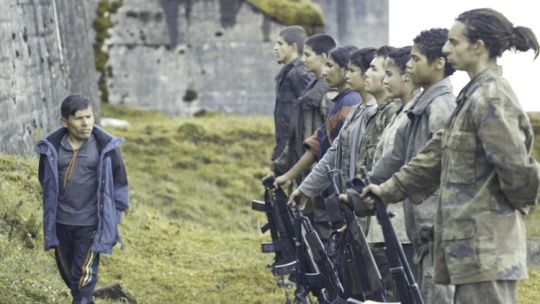
One of the more interesting releases of the weekend is the Colombian film MONOS (Neon /Participant Media) from director Alejandro Landes that centers on a pack of wild gun-toting teenagers living on a mountaintop in the South American jungles where they run sort of wild but also are well-trained as a fighting unit. They actually have taken a hostage, a doctor played by Julianne Nicholson, who is just great in this role, continuing to show off how she’s one of the most underrated actresses working today. There’s definitely a “Lord of the Flies” feel to Landes’ film which has been submitted by Colombia as its Oscar submission for the newly-labelled “Best International Film Festival,” and I wouldn’t be surprised if it finds enough fans to get into the short-list, at least. Not sure about the nomination as this is already a tough year with high-profile submissions like the new Almodovar and Bong Joon-ho’s Parasite. Still, I think this will find its share of fans, and I can recommend it for its artistry more than as something you must rush out to see.
GKIDS’s latest animated release is ANOTHER DAY OF LIFE, based on the book by journalist Ricardo Kapuscinski that looks at the outbreak of civil war in Angola after being freed of its independence from Portugal in 1975. The autobiographical film follows Kapuściński’s search for the rebel leader Farrusco through wartorn Angola, so this is very much an animated documentary similar to Waltz with Bashir. It will open in New York at the IFC Center and in L.A. at the Laemmle Glendale this Friday.
And then there’s Michael Tyburski’s THE SOUND OF SILENCE (IFC Films), which stars Peter Sarsgaard, an actor I generally like, as a “house tuner.” Basically, he goes into people’s apartments and find out what notes or tones are causing them anxiety or preventing them from sleeping. One of his clients is a woman, played by Rashida Jones, and they sort of have a thing going, but Sarsgaard’s character is so strange and the movie is so slow, I didn’t really get more than an hour into this before I gave up. This was based on a short film called “Palimpsest,” and while “The Sound of Silence” is a much better title, this is a concept that probably works best as a short, since as a feature, it’s boring as fuck.
Another Friday the 13thhorror release is Scott Becks and Bryan Woods’ HAUNT (Momentum Pictures), which follows a group of friends who go into an “extreme haunted house” on Halloween in a night that turns deadly. Unlike the movies mentioned above, I feel that this really should have been held until next month, because it’s just going to get lost in the shuffle of all of the releases this weekend.
Since this column doesn’t post until Wednesday, I should probably mention that Rob Zombie’s new movie 3 from Hell will get a three-day wide release on Monday, Tuesday and Wednesday in about 500 theaters, each day offering another bonus. It’s a direct sequel to The Hell’s Rejects, a movie I actively hated, and this one is more of the same, so I can’t recommend it at all. I hated this movie, and it’s use of violence for entertainment. UGH.
Let’s get to a few documentaries, a few of which I’ve seen...
Opening at the IFC Center is Michelle Esrick’s Cracked Up, a movie about “Saturday Night Live” vet Darrell Hammond and the history of childhood trauma he kept locked up for 40 years. I missed this at Doc-NYC last year but both Hammond and Esrick will be at the IFC Center Friday evening to answer questions.
Irene Taylor Brodsky’s Moonlight Sonata: Deafness in Three Movements (Abramorama) opens at New York’s Landmark 57 Friday and in L.A. at the Lammle Royal on Friday, Sept 20, and it’s an interesting film for the director of Beware the Slenderman, an excellent doc from a few years back. It looks at three people dealing with deafness, a young boy, an aging grandfather and no less than Ludwig van Beethoven, their stories weaved together to explore what it means to be deaf.
I had mixed feelings on Liam Gallagher: As It Was (Screen Media), which will be in theaters this Friday, available via Digital Download Sept. 17 and on VOD platforms Oct. 8. I saw and liked the Oasis doc Oasis: Supersonic a few years back, but Gavin Fitzgerald and Charlie Lightening’s doc focuses on the former Oasis frontman and his fall from grace after his very public feud with his brother Noel Gallagher put the spotlight on a singer who I personally feel is an egotistical prat… and he goes about proving that in every scene of this movie. The movie covers how the break-up of Oasis led to Liam immediately starting Beady Eye, which proved to be a failure before he decides to go solo. Maybe it isn’t a coincidence that this is being released a week before Gallagher’s new solo album “Why Me? Why Not.”
After playing last year’s Fantastic Fest and the recent Fantasia and BAMCInemaFest, Aaron Schimberg’s Chained for Life will be released at the IFC Center on Weds and at the Landmark Nuart in Los Angeles on Friday. The movie stars Jess Weixler as movie star Mabel, who has been slumming it in art-horror film being shot in a hospital opposite Rosenthal (Adam Pearson), a gentle young man with a severe facial deformity, as their relationship grows.
Elise Duran’s high-concept rom-com Can You Keep a Secret? (Vertical) is based on Sophie Kinsella’s novel and it stars the super-cute Alexandra Daddario as a New York woman who is having troubles in life and when turbulence hits her plane, she confesses all her secrets to her neighbor, who turns out to be the company’s CEO.
Next up is a bunch of odds and ends including some VOD specials. Opening in New York and L.A. is Larry Clarke’s comedy 3 Days with Dad (Unified Pictures), starring Tom Arnold who returns home to deal with his dying father. There’s also the Bollywood courtroom drama Section 375 (Reliance Entertainment), directed by Ajay Bahl. Jim Gaffigan’s second movie of the year, American Dreamer (Saban/Lionsgate), co-written and directed by Derrick Borte (The Joneses), has him playing a ride-share driver who kidnaps the child of a drugdealer. It opens at New York’s Cinema Village Friday and in L.A. and VOD next Friday. There’s also Garrett Batty’s Out of Liberty (Purdie Distribution), and I’m not even sure what to say about Seth Prices’ Redistribution, opening at the Metrograph, except that it’s a “reflexive work on art and interpretation.” Make of that what you will…. Or just check out the weird trailer.
youtube
LOCAL FESTIVALS
On Thursday begins the Tribeca TV Festival, which will showcase some of the newest and most anticipated television shows of the fall season including ABC’s Bless This Messwith Lake Bell, Dax Shepard and Pam Grier in attendance; the Apple+ series Dickinson, starring Hailee Steinfeld and Jane Krakowski; the CBS series Evil; and much more. Click on the link above to see what’s going to be screening, but it’s a pretty impressive line-up if you’re an avid TV watcher.
REPERTORY
METROGRAPH (NYC):
The Welcome To Metrograph: Redux series continues this weekend with Andrei Tarkovsky’s Andrei Rublev (1966) and Fellini’s Amarcord (1973), while Late Nites at Metrograph will screen Buñuel’s Belle du Jour (1967) and Playtime: Family Matinees will screen Charlie Chaplin’s 1931 film City Lights.
ALAMO DRAFTHOUSE BROOKLYN (NYC)
Monday night is Franc Roddam’s 1979 film Quadrophenia, based on The Who’s concept album, while this week’s “Tuesday Terror” is Dario Argento’s 1975 film Deep Red, which ironically, Italian rockers Goblin will be in town playing the score for LIVE at the PlayStation Theater on Friday in case you miss it at the Alamo. (Although tickets are obviously much more expensive for the concert.) Next week’s “Weird Wednesday” is the Rutger Hauer movie Split Secondfrom 1992.
EGYPTIAN THEATRE (LA):
Thursday will be a 40thAnniversary screening of Breaking Away with some of the cast in person, while Friday is a hockey double feature of Slap Shot (1977) and Sudden Death (1995). Saturday is a 70mm screening of Paul Thomas Anderson’s The Master, while Sunday is a double feature of The Godfather (1972) and The Godfather Part II (1974). Also Sunday, the George Lucas Family Foundation sponsors a screening of the 1919 silent film The Son-of-a-Gun (in 8mm!!!)with musical accompaniment, as well as some of Gilbert Anderson’s other shorts from the time.
AERO (LA):
Wednesday’s Greg Proops Film Club will screen Fritz Lang’s Ministry of Fear (1944) in 35mm, while Thursday begins a series of “Anime Double Features” of Ninja Scroll (1993) with Vampire Hunter D (1985). Friday is a Satoshi Kon anime double feature of Millennium Actress (2001) and Perfect Blue (1997). Saturday’s Anime double feature isRedline (2009)and Ghost in the Shell (1995), while Sunday is a Studio Ghibli double feature of Grave of the Fireflies (1988) and Only Yesterday (1991). Tuesday’s “Heptember Matinee” is a new 4k restoration of Katherine Hepburn’s Holiday from 1938.
BAM CINEMATEK (NYC):
BAM begins an awesome appropriate series called “Purpose and Passion: The Cinema of John Singleton,” showing a lot (if not all) of the late filmmaker’s work, including Boyz in the Hood, Poetic Justice, Higher Learningand even more recent movies like Four Brothers, Abductionand his 2000 Shaft, starring Samuel L. Jackson. This week’s “Beyond the Canon” offering on Saturday is a double feature of Valie Export’sInvisible Adversariesfrom 1977 and Invasion of the Body Snatchersfrom 1978. It’s also showing Craig Brewer’s Hustle and Flow, starring Terrence Howard, which Singleton produced.
FILM AT LINCOLN CENTER (NYC):
On Thursday, Film at Lincoln Center begins a short series called “Two Free Women: Lily Tomlin & Jane Wagner” which should be fairly self-explanatory, focusing the spotlight on the actor/comedian and her life partner, which will include a conversation with the two women on Saturday evening. The series will open with John Bailey’s The Search for Signs of Intelligent Life in the Universe (1991) on Thursday night with a QnA with the two women. The rest of the series includes All of Me (1984), 9 to 5 (1980), Big Business (1988), Nashville (1975), the recent Grandma (2015) and many more films, including Nick Broomfield’s doc Lily Tomlin.
IFC CENTER (NYC)
Weekend Classics: Staff Picks Summer 2019 is Sean R’s pick Labyrinth (1986) while Waverly Midnights: Staff Picks Summer 2019 is the GREATEST STAFF PICK OF ALL TIME… Alex Cox’s 1984 classic Rep Man, picked by Jeff! Late Night Favorites: Summer 2019 is a 35mm print of Scorsese’s Mean Streets. (As far as I can tell, the 4k restoration of David Lynch’s Blue Velvet is ending on Thursday.)
FILM FORUM (NYC):
This weekend’s “Film Forum Jr.” is three Laurel and Hardy shorts and on Monday is a screening of Preston Sturges’ 1941 film The Lady Eve, starring Barbara Stanwyk, with a QnA and signing with Sturges’ son Tom. Joseph Losey’s Mr. Klein will continue running through Thursday, Sept. 19.
MUSEUM OF THE MOVING IMAGE (NYC):
Not really repertory but MOMI is playing the director’s cut of Ari Aster’s Midsommar this weekend as well as Makoto Shinkai’s amazing 2017 film Your Name, the latter on Saturday and Sunday at noon.
ROXY CINEMA (NYC)
On Weds., Thursday and Sunday, the Roxy is showing a 35mm print of David Byrne’s True Stories from 1986, which seems to have found new life over 30 years since its debut.
LANDMARK THEATRES NUART (LA):
This week’s midnight movie on Friday isJohn Cameron Mitchell’s Hedwig and the Angry Inch from 2000!
THE NEW BEVERLY (L.A.):
Sorry, Quentin, but as long as you use your excellent rep theater just to show Once Upon a Time … in Hollywood, the New Bev will remain at the bottom of this section. The Wednesday matinee is Possessed (1947), starring Joan Crawfors, while the weekend’s “KIddee Matinee” is a classic… 1965’s The Sound of Music! There’s a special Cartoon Club on Saturday morning and Pulp Fiction is the Saturday midnight and then Monday’s matinee is Fast Times at Ridgmont High (1985) in 35mm.
STREAMING AND CABLE
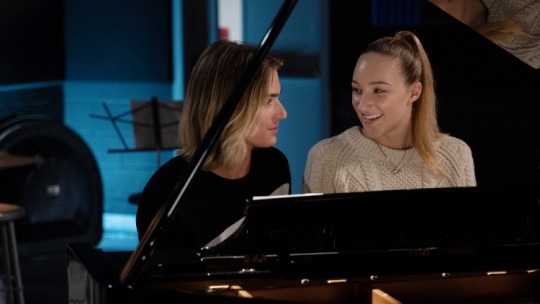
Probably more than anything, I’m excited for the return of Jon Favreau’s The Chef Show this Friday, but there’s also a new original film called TALL GIRL, directed by Nzingha Stewart and starring Ava Michelle as the tallest girl in school (hence the title), who deals with being so tall until she meets Luke Eisner’s Stig, a Swedish foreign exchange student who is even taller than her. It’s another cute teen-targeted rom-com from Netflix that I’m not sure I’ll ever see.
Next week is a mix of stuff including James Gray’s Ad Astra, starring Brad Pitt; Sylvester Stallone is back as Rambo: Last Blood and Downton Abbeyr eturns… but only in theaters.
0 notes